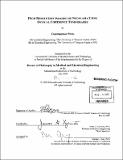| dc.contributor.advisor | James G. Fujimoto. | en_US |
| dc.contributor.author | Pitris, Constantinos D | en_US |
| dc.contributor.other | Harvard University--MIT Division of Health Sciences and Technology. | en_US |
| dc.date.accessioned | 2005-08-23T21:16:31Z | |
| dc.date.available | 2005-08-23T21:16:31Z | |
| dc.date.copyright | 2000 | en_US |
| dc.date.issued | 2000 | en_US |
| dc.identifier.uri | http://hdl.handle.net/1721.1/8560 | |
| dc.description | Thesis (Ph. D.)--Harvard--Massachusetts Institute of Technology Division of Health Sciences and Technology, 2000. | en_US |
| dc.description | Includes bibliographical references (leaves 145-156). | en_US |
| dc.description.abstract | Diagnostic imaging technologies for the detection of cancer include CT, MRI, ultrasonography, and endoscopy. However, many early neoplastic changes remain beyond their detection limits. A modality capable of imaging at or near the cellular level could detect disease at earlier stages than currently possible and thus improve patient prognosis. Optical coherence tomography (OCT) can achieve resolutions in the cellular and subcellular range (1-15 [mu]m) and could improve the diagnostic range of clinical imaging procedures. The research described in this thesis includes the ex vivo imaging surveys, technology development and clinical studies necessary to demonstrate the feasibility of OCT imaging for the in situ diagnosis of premalignant and neoplastic lesions. The first step in this endeavor was to evaluate the performance of OCT using ex vivo tissue specimens and identify the features in the OCT images which can be used for the diagnosis of disease. The development of the technologies necessary to introduce OCT to clinical settings, including a portable system and imaging devices, ensued. Enhancements in the post processing and visualization algorithms were introduced and the feasibility of ultra-high resolution and spectroscopic imaging was evaluated. In vivo OCT imaging, to assess the performance of the technology in clinical scenarios, followed in two systems, the cervical and oral mucosa. OCT can function as a type of optical biopsy to yield image information with resolutions approaching that of conventional histopathology in situ, without the need for excision and processing. OCT can be integrated to a wide range of clinical instruments including endoscopes, catheters, laparascopes, and surgical probes. A role for OCT is envisioned in clinical scenarios such as the follow-up management of patients with cervical intraepithelial neoplasia, on tamoxifen, with gastro-esophageal reflux or Barrett's and also guidance of surgical procedures in sensitive areas. Further improvements of the OCT technology will most likely enhance the abilities of the technique and may eventually lead to its establishment as a a powerful imaging modality for the diagnosis and management of cancer. | en_US |
| dc.description.statementofresponsibility | by Constantinos Pitris. | en_US |
| dc.format.extent | 156 leaves | en_US |
| dc.format.extent | 23538181 bytes | |
| dc.format.extent | 23537941 bytes | |
| dc.format.mimetype | application/pdf | |
| dc.format.mimetype | application/pdf | |
| dc.language.iso | eng | en_US |
| dc.publisher | Massachusetts Institute of Technology | en_US |
| dc.rights | M.I.T. theses are protected by copyright. They may be viewed from this source for any purpose, but reproduction or distribution in any format is prohibited without written permission. See provided URL for inquiries about permission. | en_US |
| dc.rights.uri | http://dspace.mit.edu/handle/1721.1/7582 | |
| dc.subject | Harvard University--MIT Division of Health Sciences and Technology. | en_US |
| dc.title | High resolution imaging of neoplasma using optical coherence tomography | en_US |
| dc.type | Thesis | en_US |
| dc.description.degree | Ph.D. | en_US |
| dc.contributor.department | Harvard University--MIT Division of Health Sciences and Technology | |
| dc.identifier.oclc | 49090880 | en_US |
